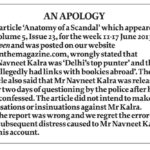A highway across the Kanha-Pench landscape might just deny the tiger its best chance of survival.
Forget the felled trees, and the highway, for a moment. These are mere props in this theatre of the absurd. But the climax will indicate which way the fine balancing act of growth-vs-green is likely to go in the future.
The plot unfolds in the heartland of erstwhile Gondwana—a ‘dark mysterious blank’ on the map of the British Empire of yore until the mid-nineteenth century, when a young Captain, James Forsyth, started exploring the dense and dangerous tiger forests of central India with the scientific curiosity of a geologist.
One-and-a-half centuries since, much has changed in this land of the Gond tribe. Rail and roadways crisscross the lush landscape that has survived development and deforestation in democratic, independent India. The remains of the mighty forests still constitute India’s best green landscape with an intricate network of national parks and sanctuaries. Fittingly, Kamal Nath, one of the tallest political leaders of this green belt, became India’s environment minister in 1991.
Two decades on, the Member of Parliament from Chhindwara today holds the portfolio of Road Transport and Highways. Today, against the collective wisdom of the country’s best experts, the National Highways Authority of India (NHAI) wants to roll out highways on Nath’s home turf, cutting through and cutting apart India’s best, and last, surviving forests.
According to the National Tiger Conservation Authority (NTCA) and Wildlife Institute of India (WII), in 2008, the forest landscape connecting Kanha and Pench tiger reserves is one of the four most viable tiger habitats in the country (the other three being the Western Ghats, Corbett and Kaziranga). This 16,000 sq km landscape has two source populations and a total of 141 tigers. This is also home to some of India’s most endangered species, such as gaurs (Indian bison) and dhols (Indian wild dog).
Forest connectivity makes a landscape superior wildlife habitat, allowing animal movement and gene flow. In the absence of forest corridors, small tiger populations in isolated reserves face the risk of local extinction—either due to poaching in the short term or due to genetic decay over generations. Sariska is a prime example.
The Kanha-Pench landscape thrives on its healthy contiguity. In isolation, the tiger population of about 30 at Pench is far from viable. The area of Pench tiger reserve (411 sq km) in itself is insufficient for a viable habitat. As per NTCA, a population is not viable below 80-100 tigers, and for such a population, at least 800-1,000 sq km of habitat is required. Clearly, the connectivity to Kanha (917 sq km, 89 tigers) is key to keep the tiger population at Pench viable. The same is true for the other mega fauna in the area.
Almost 9 km of the Nagpur-Jabalpur road—National Highway No 7 (NH7)—passes along the periphery of the Pench Tiger Reserve, notified by the Madhya Pradesh government as core critical tiger habitat under the Wildlife (Protection) Act. Another 47-km-stretch of this road cuts through areas under South Seoni Forest division that serves as a buffer for Pench and has several forest corridors to Kanha.
As part of the Golden Quadrilateral project, the NHAI decided to widen this 2-lane road to a four–lane highway in 2006. The Madhya Pradesh government, on its part, cleared the proposal and forwarded it to the Centre for approval. Since the project involved both impact on a tiger reserve and use of forest land, it required clearance from the National Board for Wildlife (NBWL) and the Forest Advisory Committee (FAC) as well.
The NBWL rejected the NHAI plan in September 2008. The FAC reserved its opinion since Wildlife Trust of India (WTI), a non-governmental organisation, had already filed a petition before the Central Empowered Committee (CEC), set up by the apex court in 2003 to advise it on technical matters of wildlife and forestry.
Seeking to stop tree felling and construction work along the sensitive stretch, the WTI application said: ‘The use of forest land falling in the Pench Tiger Reserve, the South Seoni Forest Division and the Nagpur Division can be avoided by using an alternative route via Chhindwara and Seoni. This alternative route though approximately 55 per cent longer than the existing one, must still be preferred to protect such a vital habitat.’
The CEC took the case to the Supreme Court, and the NHAI, on its part, offered to construct either an elevated 9-km road over the forest or a few underpasses for the movement of wild animals.
In November 2008, Dr Rajesh Gopal, member secretary of NTCA, made a field inspection as a CEC invitee and his report explained why the proposal for road widening would ‘irreversibly damage the tiger habitat’ and ‘should be implemented under no circumstances’. His report noted: ‘No safeguards would restore the said habitat to its present status. Most of the safeguards/retrofilling structures for wildlife are suggested (by NHAI) on the basis of practices in vogue abroad for smaller animals which may be meaningless in the context of tigers and their larger prey animals. The alternative route would save the priceless habitat.’
The CEC itself made a site visit in March 2009, and in its report, backed Dr Gopal’s position. ‘The CEC is of the considered view that the proposed (project) will cause irreparable damage to one of the most important and critical wildlife habitats in the country. It is one of the last, perhaps the only, extensive track of wildlife habitat covering an area of 16,000 sq km. Such a habitat should be further consolidated and protected rather than be allowed to be fragmented and destroyed. The ecological cost of the present project is immense and no mitigative measures are adequate to compensate the same,’ the report said.
The CEC also convened a meeting in May 2009 to consult representatives of the NHAI, MP Forest Department, WII, WTI and a number of wildlife experts. All the experts—‘without any exception or reservation’—agreed that the proposed four-laning would be disastrous.
‘The landscape, being one of the most important wildlife areas in the country, needs to be preserved and protected at any cost. The experts were of the view that it is absolutely imperative that the National Highway is realigned and the additional cost and the increased length of the road on this account should not be a limiting factor,’ the CEC noted.
So far, it seemed an open and shut case. But days before the case came up for a hearing before the apex court on 15 January, amicus curiae Harish Salve in his note suggested that the widening of the highway be allowed with provisions for a few underpasses as sought by the NHAI.
Consider how the amicus curiae deviates from the CEC report:
» ‘The NHAI has suggested an alternate (sic) proposal and in respect of which it claims that it has the approval of State Board of Wildlife and National Board of Wildlife. This proposal envisages building underpasses in the stretch and fencing the entire 9 km.’
This is factually incorrect, as the NBWL rejected any such proposal on 18 September 2008.
» ‘NHAI claims that after the detailed deliberations with the various forest authorities, it has been agreed that’ 13 underpasses will be made, 2.5 metre chain link fencing will be camouflaged by vegetations, road land will be restricted to 30 metres, and forest land used for temporary diversion of traffic will be ‘restored to original’.
None of the top four forest and wildlife authorities in the case—NBWL, FAC, NTCA or WII—agreed to any of these proposals. So who are these ‘various forest authorities’?
» Salve’s note further states that to reduce the traffic pressure on the forest stretch of NH7, NHAI should be directed to develop the available alternative alignments as well. Put simply, Salve advises the court to start construction on all major roads in the area. If the NHAI is indeed instructed to improve the alternative alignments, why widen the sensitive road at all? Or is it, if the buzz in political circles in Madhya Pradesh is to be believed, to let Kamal Nath develop as much road length as possible on his home turf?
» Finally, after listing all of NHAI’s claims, Salve goes ahead and stamps his seal of approval by suggesting that the apex court instruct the NHAI to deposit Rs 50 crore for ‘counterbalancing ameliorative measures’ since ‘there is inevitably going to be some disruption being caused to the Pench National Park’.
“The CEC report is the correct professional advice to the court. The amicus report doesn’t reflect the CEC’s concerns over conservation in the most important tiger landscape in the country,” says Sanjeev Chadha, who held the office of member-secretary when CEC filed the report. He completed his CEC term in September 2009.
“Technically, it is alright for the amicus to have a different view as long as it assists the court in coming to a fair decision. However, an ‘expert body’ such as CEC was created to assist the court on expert matters, and hence the amicus should ordinarily not have a contrary view,” says Sanjay Upadhyay, a Supreme Court advocate.
While Salve has admitted that he “was mistaken about the NBWL clearance”, he takes “full responsibility” for his note. “My suggestions are never in suppression of any statutory authority. Obviously, the SC permission is in addition to and not in substitution of their (NBWL) clearance. So the last word is always with the NBWL. The clearance from the SC is in addition to all clearances, not in lieu of them,” he tells Open.
Counters Upadhyay: “With all due respect to the learned amicus, it is the SC which is the final arbiter and not the NBWL. The NBWL is the highest statutory body under the Wildlife Protection Act and needs to act in accordance with the letter and spirit of the Wildlife Act. The SC has the full authority to take a different stand if it finds that such a view of the NBWL is not in accordance with law.” Moreover, there is no instance when a project cleared by the SC was subsequently turned down by the NBWL.
Salve also maintains that his note need not reflect the CEC advice: “There is no question of dilution. The CEC’s advice is being contested by the NHAI and the Court wanted my view in the matter. I felt that the balance between the need for development and construction of the road was a midway found acceptable to all.”
But the consensus reflects the opposite. “The CEC report is the outcome of a series of consultations with and field inspections by the best experts of the country. Its recommendations are the final technical view and should be binding,” says Ashok Kumar of WTI.
Raj Panjwani, a senior Supreme Court advocate, agrees. “The NBWL, NTCA, WII and CEC have all rejected the project. Even if the amicus curiae has taken a different stand, the opinion of the technical bodies should prevail,” he says.
The SC has asked for the opinion of the Ministry of Environment and Forests (MoEF) and the next hearing is due on 21 January.
Says eminent tiger scientist Dr Ullas Karanth: “This case will have bearing on hundreds of such cases. The basic approach of the NHAI is wrong. These roads were made centuries back when land use patterns were different. Today, we need new alignments wherever necessary to safeguard the few remaining forest landscapes of India.”
Little wonder that the CEC minced no words when it stated that this is one of those exceptional cases where ecological security must necessarily take precedence over developmental needs.
Says Ashok Kumar: “I respect the Judiciary’s impeccable record on upholding environmental causes. Our courts have done a great deal for conservation. I am keeping faith.”
(Mazoomdaar is an independent journalist.)
/wp-content/uploads/2015/11/frontier-option2.jpg)

/wp-content/uploads/2025/04/Cover-Rashmika-New.jpg)











More Columns
Saving Farmers from the Unions Siddharth Singh
The New Hotspot Kaveree Bamzai
Chills and Spills in Small Town America Kaveree Bamzai